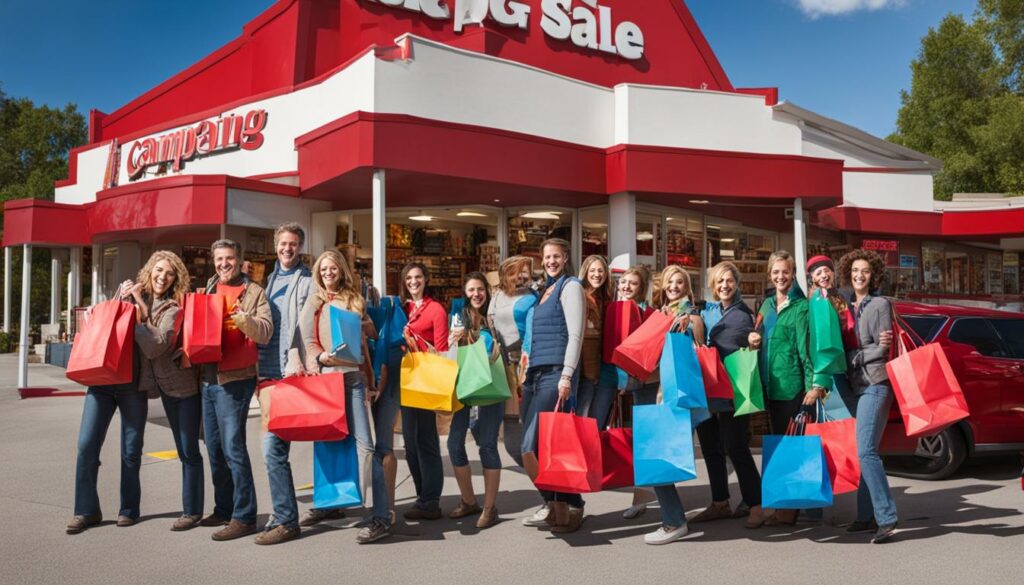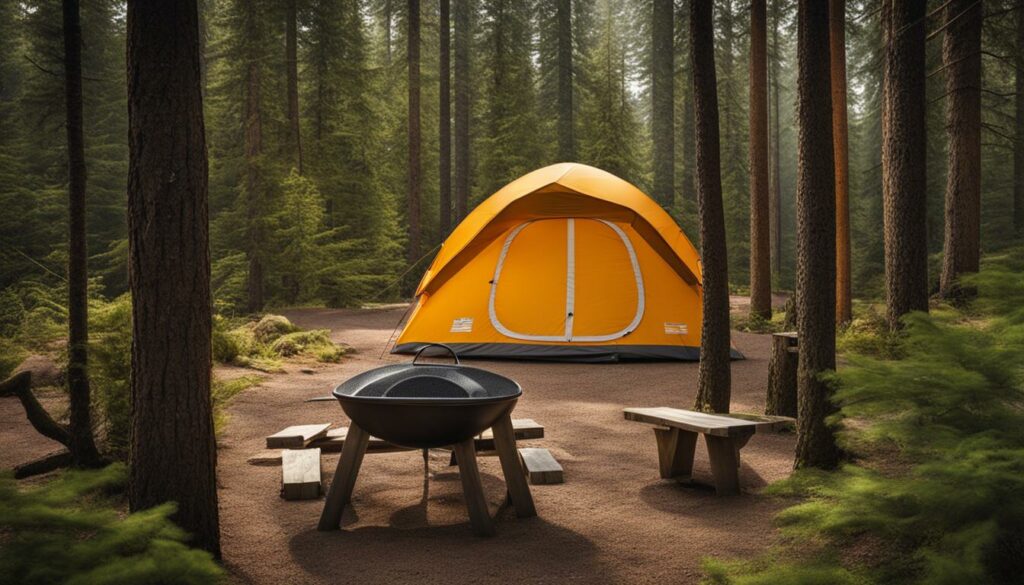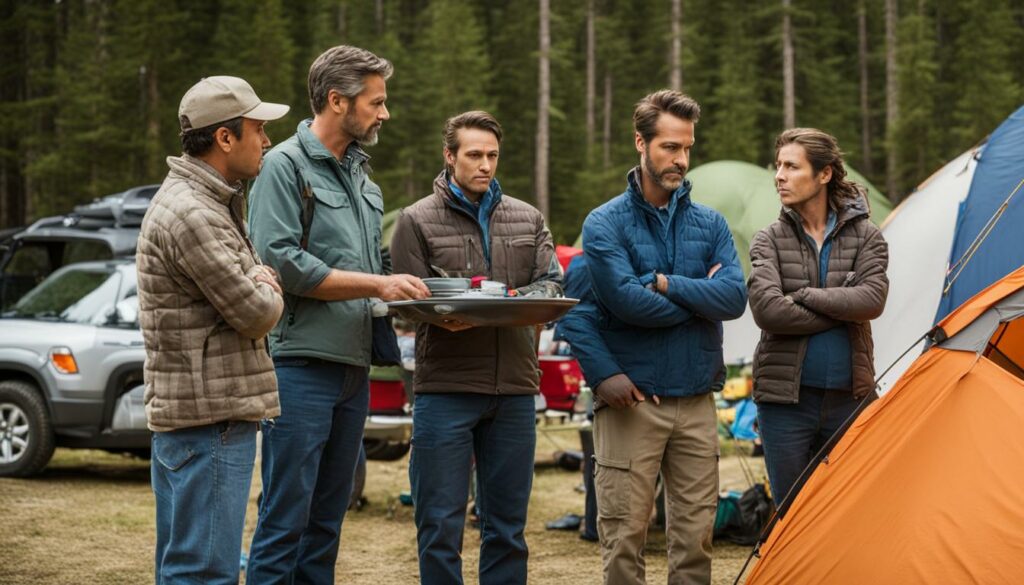Running a campground is no small feat, and one of the biggest challenges faced by campground managers is cost management. With expenses constantly mounting and a tight budget to adhere to, it’s essential to adopt cost-effective purchasing practices to ensure long-term viability and growth. In this article, we’ll explore different ways that campground managers can save money through affordable procurement strategies, helping them to stay within budget while providing a better camper experience.
Key Takeaways:
- Cost-effective purchasing is vital for ensuring the financial sustainability of campgrounds.
- Adopting affordable procurement strategies helps campground managers save money while enhancing the camper experience.
- Through effective cost management, campground managers can optimize their budgets and allocate resources more efficiently.
- There are several strategies available for achieving cost-effective purchasing, including group buying, inventory management, building relationships with suppliers, and analyzing total cost of ownership.
- Measuring cost-effectiveness and regularly evaluating procurement strategies can help campground managers to improve their cost-saving efforts over time.
Understanding the Campground Supplies Market

Campgrounds require a wide range of supplies to ensure campers have a comfortable and enjoyable experience. These range from essentials such as tents and sleeping bags to cooking equipment, first aid kits, and campsite furniture. However, procuring these supplies at a reasonable cost can be challenging. To address this issue, it is essential to understand the campground supplies market and the options available for economical procurement.
One way to source camping gear deals is by building relationships with suppliers. Consider reaching out to manufacturers directly and negotiating discounts for bulk orders or signing up for seasonal sales promotions. Additionally, many online retailers offer affordable procurement options for campground supplies. With a little research, campground managers can take advantage of these deals to save money while still providing quality camping gear for their visitors.
To make informed purchasing decisions, it helps to have a comprehensive understanding of the different types of supplies available and their varying price points. The table below provides a breakdown of common campground supplies and their average cost, highlighting some of the cheaper options available. By identifying affordable options, campground managers can provide economical solutions for their visitors without sacrificing quality.
| Supply | Average Cost | Cheap Buying Options |
|---|---|---|
| Tents | $100-$500 | Used tents, seasonal sales |
| Sleeping Bags | $50-$200 | Coupons, clearance sales |
| Cooking Equipment | $20-$150 | Bundle deals, package discounts |
| First Aid Kits | $15-$50 | DIY kits, online coupons |
| Campsite Furniture | $20-$200 | Used equipment, off-season sales |
Campground managers who understand the campground supplies market can make budget-friendly buying decisions and still meet the needs of their visitors. In the next section, we will explore specific strategies for cost-effective purchasing that can help optimize budgets.
Strategies for Budget-Friendly Buying

When it comes to cost-effective purchasing in campgrounds, budget-friendly buying is key. In this section, we will explore several strategies that campground managers can use to find cost-saving purchases and cheap buying options.
Comparing Prices
One of the simplest but most effective ways to reduce costs is to compare prices from different suppliers. By doing so, campground managers can identify the most affordable options for the supplies they need.
Negotiating Discounts
Another option for cost savings is negotiating discounts with vendors. By asking for a lower price or a bulk discount, campground managers can reduce the overall cost of purchased goods.
“Asking for a discount can be intimidating, but it never hurts to ask, and the worst thing that can happen is the supplier says no. Many suppliers are willing to offer discounts to loyal customers or for large quantity orders, so don’t be afraid to negotiate.”
Taking Advantage of Seasonal Sales
Campground managers can also take advantage of seasonal sales to purchase supplies at lower prices. By planning ahead and purchasing items when they are on sale, managers can save money in the long run.
For example, purchasing camping gear during the off-season can often provide significant cost savings. Additionally, buying in bulk during sales can lead to substantial discounts and long-term savings.
The bottom line:
By employing strategies such as comparing prices, negotiating discounts, and taking advantage of seasonal sales, campground managers can make budget-friendly purchases that contribute to cost savings and enhance the overall camper experience.
Building Relationships with Suppliers

Establishing good relationships with suppliers is crucial for any campground manager looking to save money on their purchasing decisions. By building these connections, managers can negotiate better deals, buy in bulk, and receive discounts that are not available to the general public.
One effective way to build relationships with suppliers is by attending industry events and trade shows. These events provide an opportunity for managers to meet different suppliers face-to-face and discuss their purchasing needs. Building a personal connection with a supplier can go a long way in establishing a strong relationship that benefits both parties.
“Building long-term relationships with suppliers is the key to staying competitive in today’s market. It’s not just about the price; it’s about trust, mutual respect, and understanding each other’s business needs.” – Jane Smith, CEO of Campsite Supplies Inc.
Another way to build relationships is by staying in regular contact with suppliers, even when not in the process of purchasing. Checking in periodically to see how they’re doing can help foster a positive and respectful relationship that can lead to future discounts and benefits.
It’s important to remember that building relationships with suppliers is not just about getting the best deal you can. It’s about establishing a partnership that is mutually beneficial. Suppliers want to work with customers they can trust and rely on, so building a relationship built on transparency and open communication can pay dividends in the long run.
Benefits of Building Relationships with Suppliers
| Benefits | Description |
|---|---|
| Lower Prices | Suppliers are more likely to offer lower prices to customers they have a good relationship with. |
| Improved Service | A strong relationship with a supplier can lead to better and more personalized service. |
| Prioritized Ordering | If a supplier has limited stock, they are more likely to prioritize customers they have a strong relationship with. |
| Savings on Bulk Orders | Suppliers may offer additional discounts for bulk orders to customers they have a strong relationship with. |
Prioritizing Essentials and Enhancements

To make the most of their budgets, campground managers need to pinpoint essential items and determine which enhancements are truly necessary. This can be achieved by assessing the needs of campers and prioritizing purchases accordingly.
For instance, campground essentials such as tents, sleeping bags, and cooking equipment should be prioritized over less crucial items like portable showers or RV accessories.
It’s also important to consider the longevity of products when making purchasing decisions. While certain enhancements may initially seem worthwhile, investing in durable, long-lasting essentials can provide more value in the long run.
Careful consideration of which items to prioritize can lead to more affordable procurement and cost-effective purchasing in the long run.
Example:
“Our campground was considering purchasing a new canoe rental system to improve the camper experience. However, we ultimately decided to prioritize more essential items like upgrading our restroom facilities. This decision not only saved us money but also enhanced the overall camper experience by providing a cleaner, more comfortable environment.” – Jane, Campground Manager
Analyzing Total Cost of Ownership
Cost-effective purchasing involves calculating the total cost of ownership, not just the initial price tag. By evaluating the lifespan of a product and the associated costs, campground managers can make more informed purchasing decisions.
Examples of costs to consider in total cost of ownership analysis include:
| Cost Type | Description |
|---|---|
| Upfront Costs | The initial purchase price of the product |
| Maintenance Costs | The cost of upkeep and repairs over the lifespan of the product |
| Operating Costs | The cost to operate or use the product over time (e.g. energy, fuel, or replacement parts) |
| Disposal Costs | The cost to dispose of the product at the end of its lifespan |
By considering these costs, campground managers can identify opportunities for cost savings through investing in products that reduce upkeep or operating costs over time.
Pro Tip: When evaluating the total cost of ownership, campground managers should also factor in the environmental impact of their purchases. Choosing products that are sustainable can not only save money but also promote a greener and safer camping experience for guests.
“Taking the total cost of ownership into account can lead to smarter and more sustainable purchasing decisions that benefit both the bottom line and the environment.”
Exploring Group Buying Opportunities
When it comes to budget-friendly buying, group buying opportunities can be a great option for campground managers. By pooling resources with other campgrounds, managers can take advantage of bulk discounts and reduced shipping costs.
Some group buying programs, such as Good Sam Club, offer discounts on a wide range of products including camping gear, RV supplies, and even insurance. Other programs, such as Wholesale Accessory Market, specialize in providing discounted supplies and merchandise specifically for campgrounds and RV parks.
In addition to these established programs, campground managers can also form their own buying groups with other local campgrounds. This can be as simple as reaching out to other managers in the area to coordinate bulk purchases and negotiate discounts directly with suppliers.
Benefits of Group Buying
The benefits of group buying extend beyond just cost savings. By collaborating with other campground managers, managers can share best practices and insights to improve the overall camper experience.
In addition, group buying can help build relationships among local businesses and communities. By supporting local suppliers and small businesses, campgrounds can boost the local economy and foster a sense of community around the campground.
Overall, group buying presents a valuable opportunity for campground managers to save money while also fostering community and collaboration. By exploring different group buying options and forming their own buying groups, managers can take advantage of affordable procurement options and enhance the overall camper experience in their campgrounds.
Implementing Inventory Management Systems
Implementing inventory management systems can be a game-changer for cost-effective purchasing practices in campgrounds. It enables campground managers to track and manage supplies efficiently, which results in better cost savings and reduced waste.
An inventory management system allows campground managers to keep a real-time track of inventory levels and identify which supplies need to be restocked. It helps eliminate overstocking and under-stocking of supplies, which can lead to unnecessary expenses and lost revenue.
When choosing an inventory management system, campground managers should consider several factors, including the type of software that will work best for the specific campground needs, the budget, and the familiarity of the staff with the system.
Pro Tip: Regularly analyze and review inventory data to optimize ordering quantities and timing, which can aid in cost savings.
Along with the implementation of inventory management systems, it is essential to establish protocols for ordering procedures, including utilizing standardized templates for ordering, setting up a receiving process, and conducting a physical inventory review periodically. These protocols aid in maintaining a streamlined purchasing process and contribute towards cost savings across the organization.
Evaluating Cost-Effectiveness and Measuring Success
After implementing cost-effective purchasing practices, it is essential for campground managers to evaluate their decisions to ensure that they are getting the best bang for their buck. This requires measuring the cost-effectiveness of purchases and tracking the success of cost-saving initiatives.
The first step in evaluating cost-effectiveness is to establish a baseline for comparison. This includes identifying the initial cost of an item, the anticipated lifespan or frequency of use, and any additional costs associated with maintenance or repairs. By calculating the total cost of ownership, campground managers can make informed decisions and choose items that offer the best long-term value.
Another crucial aspect of evaluating cost-effectiveness is collecting data on the effectiveness of cost-saving measures. This can include tracking the success of group buying initiatives, monitoring the impact of negotiated discounts, and analyzing the ROI of inventory management systems. By measuring these metrics, campground managers can identify areas where cost-saving efforts are paying off and adjust their strategies accordingly.
It is also important to involve staff members in the evaluation process. By soliciting feedback from employees about the effectiveness of cost-saving measures, managers can gain valuable insights and identify areas for improvement.
“Constantly monitoring and evaluating cost-effective purchasing practices can help campground managers optimize budgets, improve the quality of supplies, and enhance the overall camper experience.”
In conclusion, evaluating cost-effectiveness and measuring success is critical to the success of cost-effective purchasing practices in campgrounds. By establishing a baseline, collecting data on cost-saving measures, and involving staff members, managers can continuously improve their purchasing decisions and ensure that they are getting the best value for their money.
Conclusion
Cost-effective purchasing practices are crucial for campground managers who want to optimize their budgets and enhance the overall camper experience in their campgrounds. By understanding the campground supplies market, employing budget-friendly buying strategies, building relationships with suppliers, prioritizing essentials and enhancements, analyzing the total cost of ownership, exploring group buying opportunities, implementing inventory management systems, and evaluating cost-effectiveness, campground managers can make affordable procurement decisions that align with their budget and goals.
Implementing these strategies can lead to significant cost savings, allowing campground managers to invest in other important aspects of their business. Moreover, cost-effective purchasing practices can help boost camper satisfaction by providing necessary supplies and services at reasonable prices. Campground managers who prioritize cost-effective purchasing practices are more likely to succeed in the competitive camping industry.
Therefore, it is essential for campground managers to adopt and continuously improve cost-effective purchasing practices. By doing so, they can maximize their budget, enhance the camper experience, and ultimately achieve long-term success.
FAQ
What is cost-effective purchasing?
Cost-effective purchasing refers to the practice of buying goods and services that offer the best value for money. It involves finding affordable procurement options and making budget-friendly buying decisions while still maintaining quality and meeting the needs of the campground.
Why is cost-effective purchasing important for campgrounds?
Cost-effective purchasing is important for campgrounds as it contributes to overall budget optimization. By sourcing campground supplies at affordable prices, campground managers can save money and allocate resources to other essential areas. It also helps ensure that campers have access to quality camping gear and amenities without compromising their camping experience.
How can campground managers source campground supplies at affordable prices?
Campground managers can source campground supplies at affordable prices by exploring economical procurement options. This includes purchasing during camping gear deals, comparing prices from different suppliers, negotiating discounts, and taking advantage of seasonal sales. Additionally, building good relationships with suppliers can lead to better deals and frugal shopping opportunities.
What are some strategies for budget-friendly buying?
There are several strategies campground managers can employ for budget-friendly buying. Some examples include comparing prices and researching cheap buying options, purchasing in bulk or through group buying opportunities, prioritizing essential items rather than unnecessary enhancements, and implementing inventory management systems to avoid overstocking or wastage.
Why is building relationships with suppliers important?
Building relationships with suppliers is important because it can lead to affordable procurement options and cost savings in the long run. Good relationships can result in negotiated discounts, access to exclusive deals, and attentive customer service. By fostering strong supplier relationships, campground managers can secure the best deals and maximize their budget for campground supplies.
How can campground managers prioritize their purchasing decisions?
Campground managers can prioritize their purchasing decisions by identifying essential items that directly impact camper experience and safety. By understanding the needs of campers and considering the cost-effective alternatives available, managers can make informed decisions on when enhancements are truly necessary. Assessing the total cost of ownership, including maintenance and operational expenses, can help evaluate the financial impact of purchasing decisions.
What is the total cost of ownership?
The total cost of ownership refers to the comprehensive cost associated with owning and using a product or service over its entire lifespan. It includes not only the initial purchase price but also ongoing costs such as maintenance, repairs, and replacement. Evaluating the total cost of ownership enables campground managers to make cost-effective purchasing decisions that take into account the long-term financial implications.
Are there benefits to participating in group buying programs?
Yes, participating in group buying programs can provide significant cost savings for campgrounds. By pooling their purchasing power with other campgrounds or businesses, campground managers can access discounted rates and wholesale prices. This can result in substantial savings on campground supplies and other goods and services necessary for campground operations.
How can campground managers implement effective inventory management systems?
Campground managers can implement effective inventory management systems by utilizing digital tools and software specifically designed for inventory tracking and management. These systems help track inventory levels, monitor usage patterns, and automate reordering processes. By efficiently managing campground supplies, managers can avoid overstocking, minimize waste, and optimize cost-saving purchases.
How can campground managers evaluate the cost-effectiveness of their purchasing decisions?
Campground managers can evaluate the cost-effectiveness of their purchasing decisions by analyzing and comparing the total cost of ownership, including all relevant costs associated with each purchase. They can also consider factors such as the quality and lifespan of the product, the impact on camper experience, and the overall value it brings to the campground. Regular evaluation and measurement of cost-effectiveness allow managers to identify areas for improvement and make informed decisions in the future.





